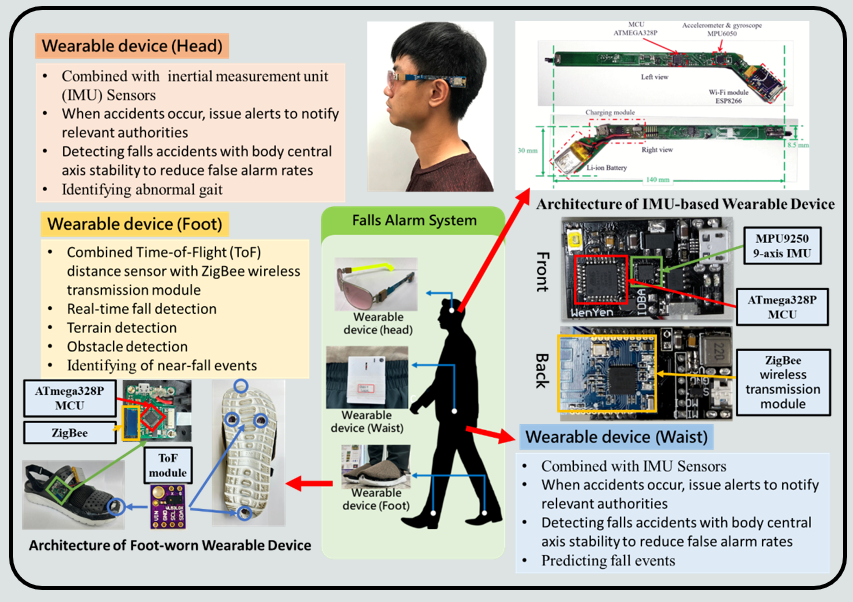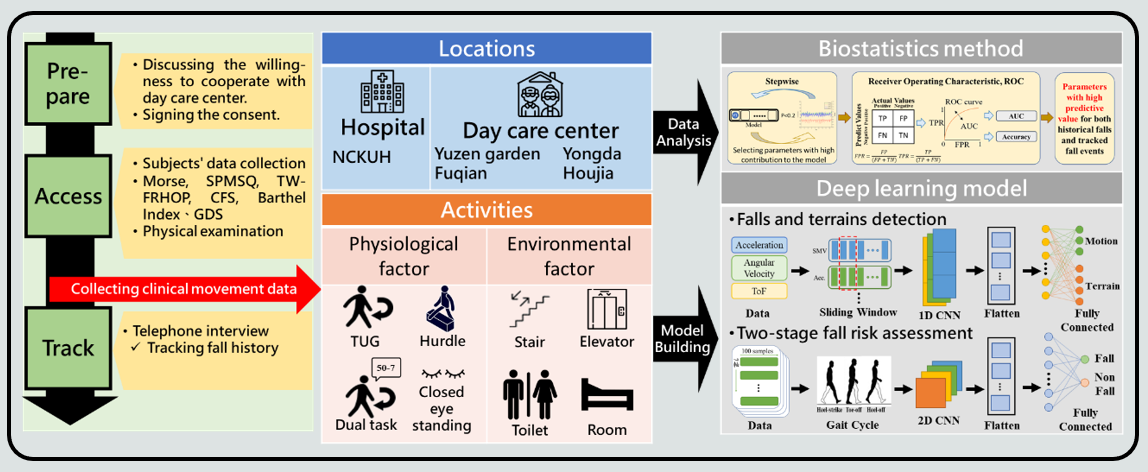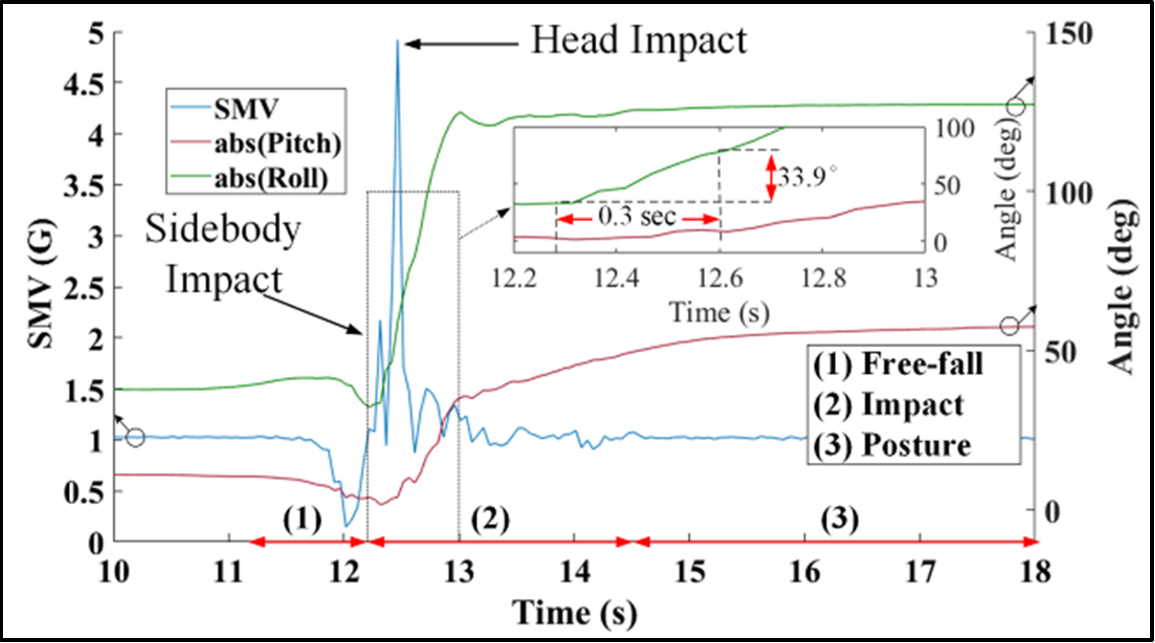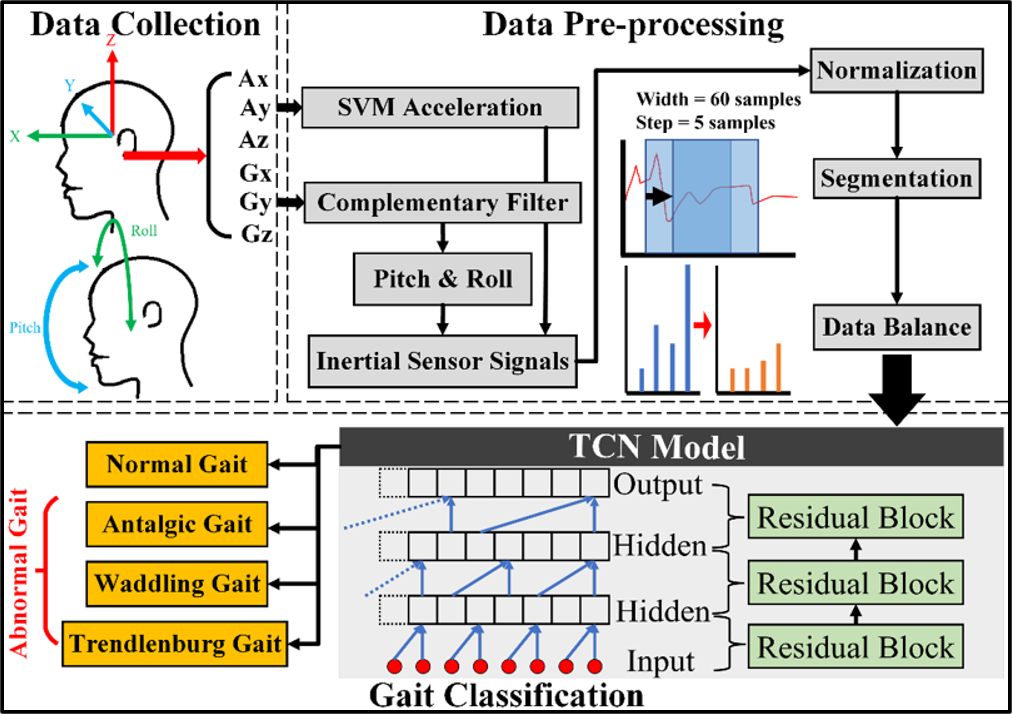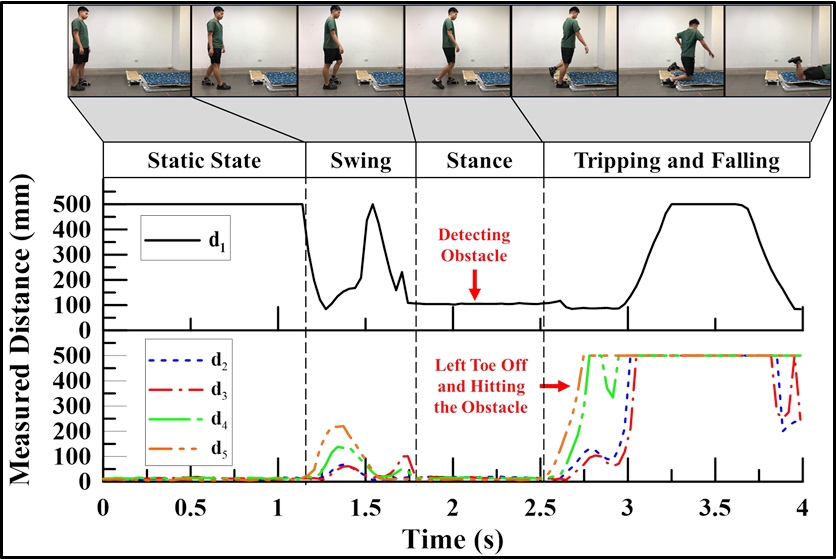| I. Research objective Falls cause psychological trauma and physical injuries in the elderly. If an elderly person is not rescued promptly after falling, it can lead to severe injuries. Our team has developed an inertial measurement unit-based multi-part wearable motion detection system. This system can capture human posture signals of head and waist in real-time and use artificial intelligence algorithms to recognize the user's current posture. It provides real-time fall identification and alarm. Additionally, the system can analyze gait information to access balance ability and predict fall events of past and future. Coupled with doctors' recommendations on rehabilitation exercises and lifestyle habits, it can effectively improve the quality of life (QoL) for the elderly. Currently, most fall detection systems cannot accurately detect falls on uneven surfaces, such as stairs or floors with obstacles. Our team has proposed a fall detection device that embeds distance sensors into the soles of shoes. This device can identify falls and near-fall movements on stairs and uneven floors. |
||
|
||
Figure 1. Multi-part Wearable System Hardware Development |
||
|---|---|---|
|
||
Figure 2. Process of Data Collection and Algorithm Development |
||
| II. Research Result The head part of our multi-part wearable device is designed like eyeglasses. During daily activities, there are no significant movements of the head, so the device can determine whether a fall has occurred by comparing root mean square (RMS) of acceleration, pitch angle, and roll angle changes using a threshold method. However, the accuracy of head rotation angle estimation can be affected by the inherent errors of the sensors. To eliminate these errors and calculate rotation angles, data from the accelerometer and magnetometer are used along with the Madgwick filter to correct gyroscope drift. Results show that the head device can achieve a fall detection accuracy of 97.75%, which not only reduces false alarm rates but also ensures high detection accuracy. Additionally, to study the relation between inertial sensor signals from the head and walking balance ability, our team has developed a model based on a deep learning neural network. The model identifies three types of abnormal gaits that carry a risk of falling due to muscle imbalance or neuropathy: Antalgic gait, Waddling gait, and Trendelenburg gait. Using IMU signals captured during a 10-meter walking test, the Temporal Convolutional Network (TCN) model is employed to classify these three abnormal gaits. These gaits may occur suddenly while walking due to pain or muscle weakness, increasing the risk of falls. The classification results show that the average accuracy, recall, precision, and F1 score were 98.33%, 98.27%, 98.2%, and 98.23%, respectively. In another experiment, subjects transitioned from normal gait to abnormal gait during walking to verify the detection time delay of abnormal gait. The average time delay is 2.52 seconds, and the detection accuracy reaches 100%. Overall, the results indicate that this method provides a new approach to monitoring gait through head movement. |
|||
|
|||
Figure 3. Visualization of IMU Data from Eyeglasses-based Wearable Device |
|||
|---|---|---|---|
|
|||
Figure 4. Analysis Process of Eyeglasses-based Wearable Device |
|||
|
Finally, based on the Time-of-Flight (ToF) distance measurement signals from a foot-worn shoe device, our team proposes a fall detection scheme to ensure accurate distance estimation. This system uses features extracted from the ToF signals and applies them to an Error-Correcting Output Codes-based (ECOC) classification model to identify 17 activities, including daily activities, near-fall events, and fall events. To validate the proposed fall detection scheme, a dataset was generated from the movements of nine subjects, comprising 450 daily activities, 216 near-fall events, and 432 simulated falls. The F1 scores for these three categories were 100%, 98.17%, and 99.07%, respectively. This experiment demonstrates that the system can accurately distinguish between near-fall events and falls on different terrains. |
|||
|
|||
Figure 5. Visualization of ToF Data from Foot-worn Wearable Device |
|||
| Related Research of our laboratory: | ||
[1] Chih-Lung Lin*, Fang-Yi Lin, Cheng-Yi Huang, Yuan-Hao Ho, Wen-Ching Chiu, and Pi-Shan Sung, "Classification of Gaits with a High Risk of Falling Using a Head-Mounted Device with a Temporal Convolutional Network," IEEE Sensors Letters, vol. 8, no. 5, pp. 1-4, May 2024. |
||
[2] Chih-Lung Lin*, Yuan-Hao Ho, Wen-Ching Chiu, Ting-Ching Chu,You-Hong Liu, "Innovative Shoe-Integrated System Based on Time-of-Flight Range Sensors for Fall Detection on Various Terrains," IEEE Sensors Letters, vol. 5, no. 10, pp. 1-4, Oct. 2021, Art no. 6002404. |
||
[3] Chih-Lung Lin*, Wen-Ching Chiu, Ting-Ching Chu, Yuan-Hao Ho, Fu-Hsing Chen, Chih-Cheng Hsu, Ping-Hsiao Hsieh, Chien-Hsu Chen, and Chou-Ching K. Lin, Pi-Shan Sung, Peng-Ting Chen, "Innovative head-mounted system based on inertial sensors and magnetometer for detecting falling movements," Sensors, vol. 20, pp. 1-16, Oct. 2020. |
||
[4] Chih-Lung Lin*, Wen-Ching Chiu, Fu-Hsing Chen, Yuan-Hao Ho, Ting-Ching Chu, and Ping-Hsiao Hsieh, "Fall Monitoring for the Elderly Using Wearable Inertial Measurement Sensors on Eyeglasses," IEEE Sensors Letters, vol. 4, no. 6, pp. 1-4, Jun. 2020. |
||
[5] Cheng-Yi Huang, Yuan-Hao Ho, Yu-Chi Hsiung, Peng-Ting Chen, Pi-Shan Sung, and Chih-Lung Lin*, "Efficient Fall Detection Method Using Time-of-Flight Sensors and Decision Tree Model," 2023 IEEE 12th Global Conference on Consumer Electronics (GCCE), pp. 1118-1119, Nara, Japan, Oct. 2023. |
||
[6] Li-Fan Tseng, Po-Ting Lee, Pi-Shan Sung, Peng-Ting Chen, and Chih-Lung Lin*, "Sit-to-Stand Time Measurement System Based on Eyewear Device for the Elderly," 2023 IEEE 12th Global Conference on Consumer Electronics (GCCE), pp. 208-209, Nara, Japan, Oct. 2023. |
||
[7] Fang-Yi Lin, Po-Ting Lee, Yuan-Hao Ho, Pi-Shan Sung, Peng-Ting Chen, and Chih-Lung Lin*, "Fall Prediction Based on Head-Mounted IMU Sensor System," 2022 IEEE 11th Global Conference on Consumer Electronics (GCCE), pp. 341-343, Osaka, Japan, Oct. 2022. |
||
[8] Meng-Hsuan Wu, You-Hong Liu, Chieh-Hsu Chen, Peng-Ting Chen, and Chih-Lung Lin*, "DTW-based Motion Matching System in Consumer Shopping Interest Analysis," 2021 IEEE 10th Global Conference on Consumer Electronics (GCCE), pp. 606-607, Kyoto, Japan, Oct. 2021 |
||
[9] Po-Ting Lee, Wen-Ching Chiu, Yuan-Hao Ho, You-Cheng Tai, Chou-Ching K. Lin, and Chih-Lung Lin*, "Development of Wearable Device and Clustering Based Method for Detecting Falls in the Elderly," 2021 IEEE 10th Global Conference on Consumer Electronics (GCCE), pp. 231-232, Kyoto, Japan, Oct. 2021. |
||
[10] Wen-Ching Chiu, Ping-Hsiao Hsieh, Feng-Ching Cheng, Chieh-Hsu Chen, Chou-Ching K. Lin, and Chih-Lung Lin*, "Implementation of Rider Assistance System with Head-up Display and Safety Notification," 2019 IEEE 8th Global Conference on Consumer Electronics (GCCE), pp. 432-433, Osaka, Japan, Oct. 2019. |
||
